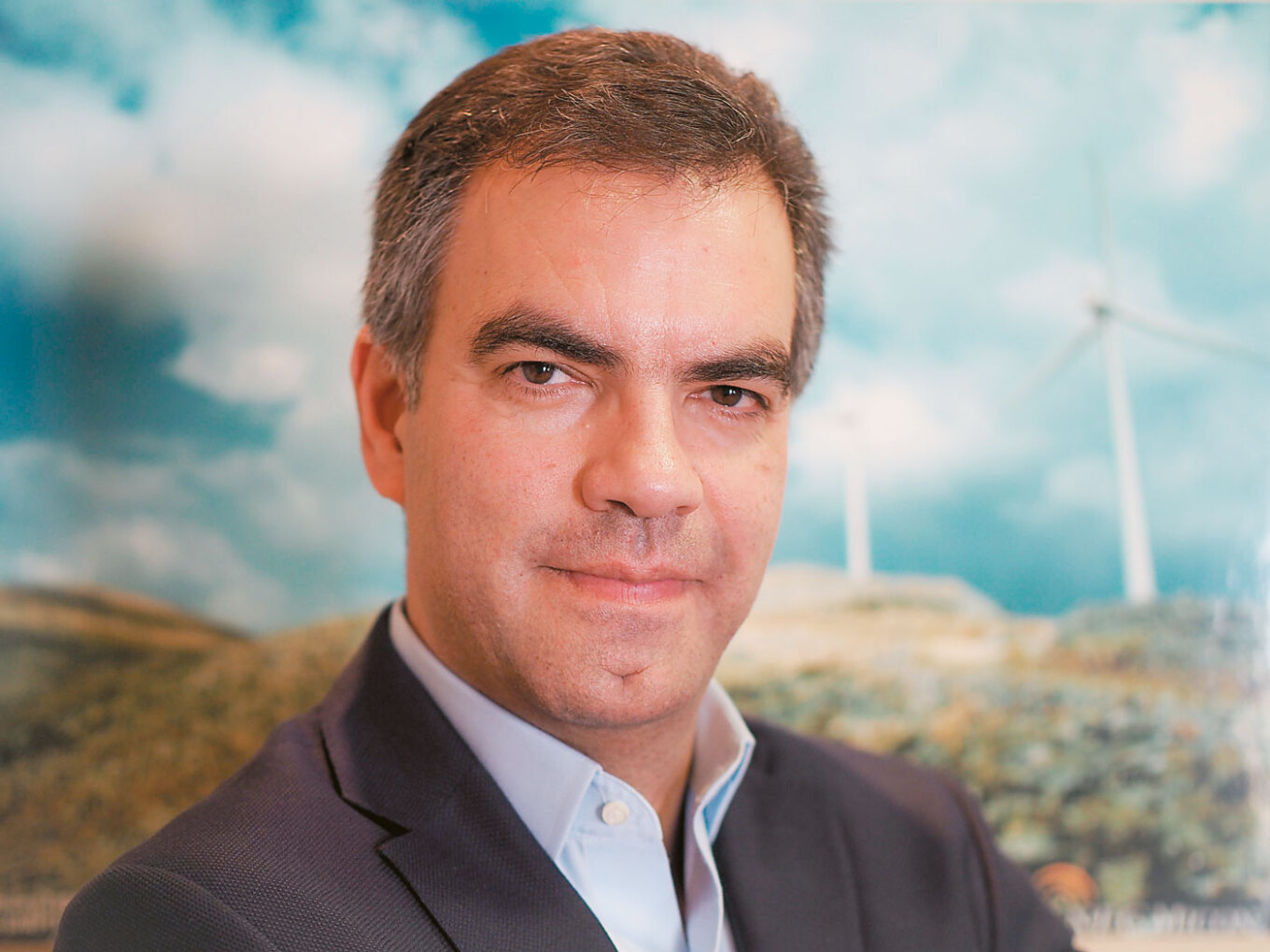If there is one topic that frequently comes up in the news for any reason, it’s none other than… wind turbines.
Whether the price of electricity goes up or down, whether we are in a period of fires or floods, the towering pillars with blades that generate energy from wind power always become a topic of discussion and enter the center of conspiracy theories.
This time, they came into the spotlight following Apostolos Gletsos’ remark during the presidential candidates’ debate for SYRIZA, when he stated that wind turbines produce zero electricity because they don’t have… batteries.
Even though as mayor of Stylida, he once literally said, “I beg, I bend over backward to get wind turbines installed.” So, what are the myths and what’s the truth about them?
In Greece, there are 3,008 wind turbines, with a total installed and operational wind power capacity of 5,326 MW, according to the latest available data.
Our country is rushing to invest in wind energy, adding it to the mix of renewable energy sources, not only to comply with EU directives but also primarily to produce its own, cheap electricity without harming the environment.
Thus, by 2030, Greece is expected to have a total installed capacity of around 11,000 MW from wind energy (which is still under negotiation), with 8.9 of that coming from onshore and the rest from offshore wind farms, meaning wind turbines placed in the sea.
Cheap energy
Despite the fact that windmills are closely tied to our history and tradition, the idea of generating electricity from wind is relatively new in Greece (if you consider that the current form of harnessing wind energy for electricity production started in 1888 in Cleveland, Ohio, USA – although there are indications it was used in ancient Greece and Persia).
The first wind turbines to operate in Greece were at the hybrid wind (and solar) park on Kythnos.
In 1982, DEI (Public Power Corporation) installed 5 wind turbines, each with a capacity of 20 KW, and the park operated, perhaps experimentally, for a few years before being abandoned, turning into a tourist attraction. However, the first useful lessons had already been learned.
Just before the Millennium, Greece had 39 wind turbines, and a year later, in 1999, it had 112 wind turbines.
It took a decade for their number to exceed 1,000 (1,087 in 2009), and now we are at the current number. What has also changed a lot over these years is their capacity.
While 30–40 years ago, a typical wind turbine had a capacity of 25 KW, today that ranges between 750–2,500 KW.
What has also changed is the cost of electricity production. Compared to 2009, it has dropped by 63%, with an IMF study finding that globally, wind energy has the lowest electricity production cost compared to other energy sources—or at least one of the lowest, according to other sources.
According to a study (Lazard, 2023), the cost of electricity production from wind turbines is $50 per megawatt-hour, compared to $180/MWh for nuclear energy, $168 for natural gas (at peak prices), $117 for oil, and $60/MWh for photovoltaic solar (using large-scale crystalline panels).
Since wind cannot be treated as a traded commodity, the price of electricity generated by wind turbines is effectively doomed to decrease, given that no ongoing purchases of additional raw materials (as is the case with fuels) are required after the initial investment for construction.
According to data from ELETAEN (Hellenic Scientific Association of Wind Energy), in the Regulatory Authority for Energy’s auction in September 2022, the average reference price for electricity from new wind farms was set at €58/MWh.
This represented a 36% reduction compared to the starting price in the first auction in 2018. For consumers, this cost became 5.5–7.5 times lower than the cost of electricity from natural gas and 3.5 times lower than lignite during the energy crisis (2022–2023) and remains consistently lower.
As it is estimated that by 2030, the share of wind and solar in domestic electricity production will increase to 68%, and to 85% by 2050, from 42% today, while the share of natural gas, lignite, and oil will drop to 18% by 2030 from 47.5% today, and below 2% by 2050, the average total cost of electricity is expected to decrease from €187/MWh to €133/MWh by 2030.
What is a wind turbine?
A wind turbine is usually installed in elevated areas where strong winds blow frequently.
It consists of a metal tower, with foundations (usually 100 square meters of concrete at a depth of three meters), and blades made of synthetic materials, typically carbon fiber or fiberglass reinforced with resin.
When wind blows, depending on its speed, the blades rotate and are connected via a hub to a low-speed shaft.
This shaft rotates at the same speed as the blades (around 8 to 20 rotations per minute), but this speed is multiplied up to 100 times by a gearbox, transferring energy to a high-speed shaft that can rotate up to 1,500 times per minute.
On average, a wind turbine will produce 175,000 MWh over at least 20 years of operation, according to a study by the scientific service of the German Federal Parliament.
In total, the energy required to manufacture the various components of a wind turbine averages 3,252 MWh.

Investors
As wind farms represent a significant part of the future in energy production (of course, all scientists agree there should be a mix of wind, solar, hydroelectric, and natural gas), investors are rushing to invest in them.
According to data from DAPEEP (Operator of Renewable Energy Sources and Guarantees of Origin), approximately €9.5 billion has been invested in the renewable energy sector over the last five years, with around 28,000 contracts signed with producers, and wind energy holding the lion’s share.
Investment interest is intensifying further as the first auction for offshore blocks in 23 areas for Greece’s initial offshore wind farms (wind turbines at sea, in regions such as Crete, Gyaros, Euboea, Rhodes, Northern Patras Gulf, and Donousa) is expected in 2027.
These parks will have a capacity of 1.9 GW, unlocking investments worth €6 billion and attracting global interest. Greece will become one of the five European countries (Denmark, the UK, Belgium, the Netherlands, Germany, France) with offshore wind farms.
As new investments loom, such as the €1 billion investment by Jeff Bezos’s Amazon for the construction of three wind farms in Greece, data from the annual Wind Energy Statistics by ELETAEN shows that in the first half of the current year, 33 new wind turbines with a total capacity of 96.9 MW were connected to the grid.
These represent investments exceeding €110 million and an annual growth rate of 3.7%. Additionally, contracts for approximately 970 MW of new wind farms have been signed, most of which are expected to connect to the grid within the next 18 months, bringing total wind capacity to 6.5 GW over the next two years.
According to the same source, the top five players in wind energy in Greece include:
- TERNA Energy with 1,034 MW (19.4% of the market),
- MORE with 766 MW (14.4%),
- Iberdrola Rokas with 409 MW (7.7%),
- Principia with 368 MW (6.9%),
- PPC Renewables with 276 MW (5.2%).
Others follow, such as Total Energies (250.2 MW), EDF (238.2 MW), METLEN Energy & Metals (236.4 MW), Jasper Energy (113 MW), Cubico (106 MW), HELENiQ Energy (99.2 MW), Aquila Capital (82.3 MW), EUNICE Energy Group (81.5 MW), among others.
During the first half of 2024, new wind farms were connected to the grid by companies such as Elica Group, Valorem, PPC Renewables, TERNA Energy, ENTEKA, and others.
Myths and Truths
Do wind turbines need batteries to produce electricity? Is there a network secretly burning forests to convert them into wind farms? Do wind turbines alter the microclimate or harm flying creatures?
Is it true that they become obsolete after a few years and are simply buried? Among the dozens of conspiracy theories, there are many questions that the average consumer has about wind turbines and how they impact their life.
Where do myths and conspiracy theories end, and where does the truth begin? Speaking to THEMA, Panagiotis Papastamatiou, the general director of the Hellenic Scientific Association of Wind Energy, clarifies the boundaries by addressing reasonable—and sometimes outrageous—questions people have about wind energy.
The Truth About Wind Turbines That Even Gletsos Doesn’t Know
Are forests burned to install wind turbines?
“This is a big lie that persists, despite documented evidence,” says Mr. Papastamatiou. “This evidence shows that wind farms installed in reforested areas occupy only 0.06% of the burned areas in the country. The truth is that if someone wanted to install a wind farm, the last thing they would do is burn the surrounding forest. This is because they would face bureaucracy and the strict regulations for reforestation, which would lead to higher costs and, above all, significant delays in starting a project.”
Fires may not occur, but are forested areas cleared to transport wind turbines to mountain peaks?
This is not a myth. The truth is that to allow trucks to transport the towers and massive blades, either existing forest roads must be widened or new ones must be built, which requires cutting down trees. “The forest vegetation, whether trees or shrubs,” Mr. Papastamatiou explains to THEMA, “is not cut down at the discretion of the investor but following a study by the Forestry Service. Moreover, everything removed is fully reforested elsewhere. For example, if the installation occupies 20 acres, with 5 acres being trees and 15 shrubs, reforestation will occur over 20 acres in another location. This location is designated by the Forestry Service and can be far from the wind farm or installation site.”
The high-speed shaft is connected to a generator that converts the kinetic energy of the shaft into electrical energy.
All of this is fine, but how does this electricity reach our homes? The generator housed in the nacelle of the wind turbine produces alternating current, which is transmitted through cables inside the tower and, from there, via underground cables to a substation installed on the ground.
At the substation, the voltage is stepped up to allow it to feed into the grid and be distributed to consumers.
When asked, “How much electricity does a wind turbine produce daily?” there is no definitive answer, as it depends on whether wind is blowing, at what speed, in what direction, and for how many hours.
If there’s complete calm on a given day, it naturally won’t produce anything. Conversely, if strong winds blow all day, it will operate at maximum capacity.
The solution to this variability lies in energy storage systems, such as batteries (as mentioned by Mr. Gletsos, albeit for a different purpose, since batteries do not generate electricity). These systems store the electricity produced instead of feeding it directly into the grid.
In cases where wind turbines and other renewable energy sources overproduce due to weather conditions, surplus electricity is created, causing electricity prices to drop to zero or even into negative territory.
In practice, grid operators “pay” consumers (essentially offsetting fixed costs) to use up electricity to avoid overloading the grid and eliminate the energy surplus.
Conversely, when wind power is insufficient, other energy sources, such as additional renewables or natural gas, are utilized.
- Is it true that the blades cannot be recycled and are buried after a few years of operation?
90% of the mass of a wind turbine (steel, copper, iron, aggregates, etc.) is fully and easily recyclable. Blades, however, are challenging because they are made from composite materials that are not easily recyclable. In the EU, burying them is permitted. “In recent years, recyclable blade materials and methods for recycling existing ones have been developed. We, along with other European scientific organizations we collaborate with, are advocating for a ban on burying blades in Europe to promote recycling.” - How long do wind turbines last before they are discarded?
“The minimum lifespan of a wind turbine is 20 years. Currently, in our country, there are wind turbines that have been operating efficiently for 25 years. When their life cycle ends in Greece, 90% of their materials are recycled, and the blades are typically sent to the cement industry. Certified companies handle the turbine materials. The blades are usually cut into small pieces, which are then used for energy recovery in the cement industry or elsewhere.” - Are wind turbines installed in protected areas, and do they kill birds?
While all environmental organizations have voiced their concerns about wind farms, the harshest critic is the Hellenic Ornithological Society, which asserts that “current practices of wind energy exploitation have significant negative impacts on the natural environment.”
The Ornithological Society identifies two types of impacts: direct (from collisions with constructions within the wind farm) and indirect (loss of habitat, barriers to movement, disturbance, etc.). Wind farms are approved on a case-by-case basis, depending on whether there are colonies of large, slow-moving birds, such as vultures, in which case approval is denied. Wind farms are permitted in Natura 2000 areas but banned in zones of Absolute Nature Protection. The Ornithological Society believes that ideally, no wind farms should be installed in any Natura 2000 areas to preserve their role as nature conservation zones.
ELATAEN (Hellenic Wind Energy Association) counters that numerous scientific studies demonstrate wind farms can coexist harmoniously with bird populations, provided proper siting and technology are used. According to late-2023 data, 31% of Greece’s total wind power (941 turbines) is within Important Bird Areas (IBAs). Data from ELATAEN indicates that the real impacts of these projects on birdlife bear no resemblance to the alarmism often generated before their installation. Moreover, any impacts that do arise can be mitigated. “There will always be some collisions,” says Mr. Papastamatiou. “However, solutions exist to minimize these and ensure bird populations remain unaffected. Ornithological radar with video monitoring and thermal cameras is installed, using Artificial Intelligence to identify the bird species approaching. If a bird is detected, an auditory signal is emitted to scare it away, with over 95% effectiveness. If the bird doesn’t leave, the system signals the turbine to stop rotating.”
- Do wind turbines emit radiation or have other effects on human health?
ELATAEN scientists are unequivocal: Wind turbines do not impact human health or the reproductive capacity of mammals. For instance, wind turbines are located in urban areas of Amsterdam, Hamburg, Boston, Toronto, near the London Eye just 10 miles from the City, and in other developed cities without… killing the population. A turbine located 200 meters away is quieter (50 dBA) than a soft-spoken conversation (60 dBA), and the electromagnetic field created by the electricity generated is of low frequency and intensity, even lower than the fields produced in cities and homes by common household appliances. As for the low-frequency noise they produce, around 20 Hertz (known as infrasound), there is no evidence of any health impact. If there were, we might first need to worry about other devices emitting the same, such as air conditioning and ventilation systems. - If wind turbines are so good, why haven’t electricity prices decreased? In fact, why do they keep rising?
“If we didn’t have wind power, electricity would be even more expensive. A new wind farm produces electricity at a stable cost for consumers of €55-65 per MWh. In comparison, for context, electricity from natural gas costs €100-120 per MWh (having reached €400 during the energy crisis), and from lignite, €200 per MWh.” 
Ask me anything
Explore related questions





